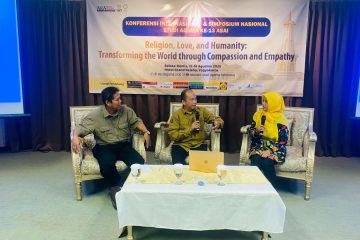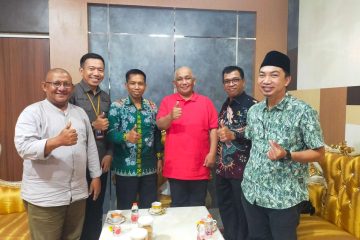The article Interfaith Response to Fire Mitigation: Islamic and Confucian Perspectives in Addressing Climate Change in Indonesia, authored by Samsul Hidayat, M. Ikhsan Tanggok, and Engseng Ho, published in 2025 in the Review of Religion and Chinese Society (Brill), offers an in-depth analysis of the role of interfaith collaboration—particularly between Muslim and Confucian communities—in mitigating forest and land fires in Indonesia. The authors situate this study within the increasingly urgent context of global climate change, focusing on a response model grounded in religious values that is both contextual and applicable at the community level (p. 1).
The introduction presents a detailed background of the increasing frequency of forest fires in Indonesia, especially in West Kalimantan, which impact not only environmental degradation but also public health and social cohesion (pp. 2–3). The authors emphasize that disaster mitigation efforts have thus far been dominated by technical approaches and state policies, while the potential of interfaith religious ethics remains underutilized. This positioning underlies the novelty of the article.
The theoretical framework integrates the concept of Wasathiyah in Islam and Zhong Yong in Confucianism as ethical principles that emphasize balance, moderation, and harmony (pp. 5–6). These principles are presented as a normative foundation that can strengthen synergy between communities in responding to ecological disasters. The authors connect these principles with the latest academic literature on ecotheology and interfaith diplomacy, thus expanding the academic discourse that has often remained fragmented between environmental studies and religious studies (p. 7).
The methodology employed is qualitative, using a case study approach on the Bhakti 28 Firefighter Foundation, a voluntary firefighting group in Pontianak composed of both Muslim and Confucian members (p. 8). Data were collected through in-depth interviews, participant observation, and document analysis, enabling the authors to trace how religious values are internalized in the actual practice of fire mitigation.
The main findings show that interfaith collaboration not only strengthens the technical capacity for fire suppression but also builds social solidarity and trust across communities (pp. 12–13). The authors provide concrete illustrations, such as how Muslim and Confucian volunteers share resources, coordinate joint patrol schedules, and hold religious reflection sessions that affirm the moral responsibility toward nature. This demonstrates the practical dimension of Wasathiyah and Zhong Yong, which has rarely been examined empirically.
In the discussion, the article positions this model within the framework of interfaith ecotheology, arguing that interfaith environmental theology can serve as an adaptive strategy to climate change (p. 15). The authors compare this approach with similar initiatives in other global contexts, such as Muslim-Christian collaboration in GreenFaith in the United States, to highlight the relevance and scalability of the Indonesian model to the international stage (pp. 16–17).
The conclusion underscores the need to integrate religious values into public disaster mitigation policies and to recognize interfaith actors as strategic partners of the state (pp. 20–21). The authors recommend replicating the Bhakti 28 model in other regions with contextual adaptation and encourage future research that incorporates quantitative methods to measure the socio-ecological impacts of such interfaith collaboration.
Overall, this article makes a significant contribution to the study of religion and the environment by offering a practical model grounded in Islamic and Confucian values. Its strength lies in successfully linking interfaith ethical theory with on-the-ground practice, supported by strong contextual analysis and rich empirical data. For academics, environmental practitioners, and policymakers alike, this article offers a fresh and applicable perspective for addressing ecological challenges in the era of climate change, while also enriching the literature on interfaith ecotheology from a Southeast Asian perspective.
Reference
《跨宗教协作应对火灾:伊斯兰与儒家视角下的印度尼西亚气候变化应对》书评
由桑苏·希达亚(Samsul Hidayat)、M. 依克桑·唐戈克(M. Ikhsan Tanggok)与何恩生(Engseng Ho)共同撰写,并于2025年发表在 《宗教与中国社会评论》(Review of Religion and Chinese Society,Brill 出版)上的文章《跨宗教协作应对火灾:伊斯兰与儒家视角下的印度尼西亚气候变化应对》,深入探讨了跨宗教合作——尤其是穆斯林与儒家群体之间的合作——在印度尼西亚森林与土地火灾治理中的作用。作者将此研究置于全球气候变化日益严峻的背景下,聚焦于一种基于宗教价值的应对模式,该模式既具有情境性,又可在社区层面切实应用(p. 1)。
文章引言部分详细介绍了印尼森林火灾的频率不断上升的背景,尤其是在西加里曼丹,其影响不仅涉及环境退化,还波及公共健康与社会凝聚力(pp. 2–3)。作者指出,迄今为止的灾害治理多由技术手段与国家政策主导,而跨宗教伦理的潜力尚未得到充分发挥,这一视角构成了本文的新颖性所在。
理论框架部分融合了伊斯兰“瓦萨提亚”(Wasathiyah)与儒家“中庸”(Zhong Yong)的概念,将其视为强调平衡、中道与和谐的伦理原则(pp. 5–6)。作者将这两大原则作为规范性基础,认为其可增强社群在应对生态灾害中的协作能力。同时,作者将这些原则与生态神学(ecotheology)及跨宗教外交(interfaith diplomacy)的最新学术成果相联系,从而拓展了原本在环境研究与宗教学之间相对割裂的学术讨论(p. 7)。
研究方法采用质性研究,运用个案研究法,聚焦于位于坤甸的“巴克蒂28志愿消防队”,该组织由穆斯林与儒家志愿者共同组成(p. 8)。数据收集包括深度访谈、参与式观察与文献分析,使作者得以追踪宗教价值在实际火灾治理行动中的内化过程。
主要研究发现表明,跨宗教合作不仅增强了灭火的技术能力,还促进了跨社群的社会团结与信任(pp. 12–13)。作者举出具体案例,例如穆斯林与儒家志愿者如何共享资源、协调联合巡逻计划,以及举办宗教反思活动以强化对自然的道德责任感。这些实例展示了“瓦萨提亚”与“中庸”在实践层面的作用,而这一层面此前鲜有实证研究涉及。
在讨论部分,文章将该模式置于跨宗教生态神学的框架之中,提出跨宗教环境神学可作为应对气候变化的适应性战略(p. 15)。作者将这一方法与其他国际背景下的类似举措进行比较,例如美国“绿色信仰”(GreenFaith)中的穆斯林—基督徒合作,以凸显印尼模式在全球舞台上的相关性与可扩展性(pp. 16–17)。
结论部分强调,应将宗教价值纳入公共灾害治理政策中,并将跨宗教行动者视为国家的战略合作伙伴(pp. 20–21)。作者建议在其他地区推广“巴克蒂28”模式,并根据不同情境加以调整,同时鼓励未来研究采用量化方法,以衡量此类跨宗教合作的社会—生态效应。
总体而言,该文通过提供一个植根于伊斯兰与儒家价值的实践模式,为宗教与环境研究作出了重要贡献。其优势在于成功将跨宗教伦理理论与实地实践相结合,并辅以扎实的情境分析与丰富的实证数据。无论对于学界、环境治理实践者,还是政策制定者而言,该文都提供了一个新颖且可操作的视角,以应对气候变化时代的生态挑战,同时从东南亚视角丰富了跨宗教生态神学的学术文献。


